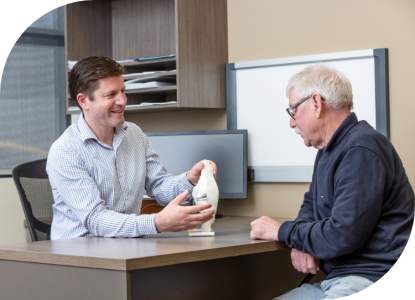Knee Arthritis
What is Arthritis?
The term ‘arthritis’ refers to any condition that results in loss of cartilage in the joint. Articular cartilage is a smooth covering on the ends of our bones that allows painless, low-friction motion in our joints. The knee joint is made up of the femur, tibia and patella (knee-cap). Several types of arthritis can affect the knee joint including osteoarthritis, inflammatory arthritis (rheumatoid arthritis, psoriatic arthritis, reactive arthritis), crystal arthritis (gout and pseudogout) and septic arthritis.
The vast majority of patients with arthritis suffer from osteoarthritis. This is a degenerative form of arthritis and is often thought of as a ‘wear and tear’ type of arthitis. As the cartilage layer wears away, bone becomes exposed inside the joint. The main symptom experienced is pain. Many patients also report stiffness, deformity, instability and other mechanical symptoms in the joint. These symptoms may limit your activity levels and very often impacts on quality of life.

Diagnosis
Osteoarthritis of the knee is very common, affecting one in eleven Australians at any one time. It is more common in ages over 45 years and in females. The exact cause for osteoarthritis in knee is often not known. Factors such as genetics, obesity, previous traumatic injury to the joint and abnormal alignment may predispose some individuals to develop osteoarthritis of the knee.
The simplest way to diagnose osteoarthritis is by taking a weight bearing xray of the knee. This may show narrowing of the joint space. Other possible findings include extra bone projections called osteophytes and subchondral cysts in the bone. If the arthritis is more focal it may not be fully appreciated on plain xrays. An MRI scan is useful in this setting.

Treatment Strategies available
Treatment strategies include physiotherapy, hydrotherapy, weight loss, activity modification, analgesic medications, injection treatments and surgery. Dr Woodbridge will carefully assess which treatments are most appropriate for your knee. Generally, surgery is reserved the patients that do not respond to conservative measures. The most common form of surgery is a Total Knee Replacement. Other less common surgical options include arthroscopy for removal of loose bodies, osteotomy (realignment procedure) or partial knee replacement (Unicompartmental Knee Replacement).
Dr Woodbridge will carefully assess patients with knee osteoarthritis and develop a treatment plan that is tailored to your individual needs. Dr Woodbridge is very flexible in his approach and is happy to involve the patient in their treatment decisions, with an emphasis on patient education.
